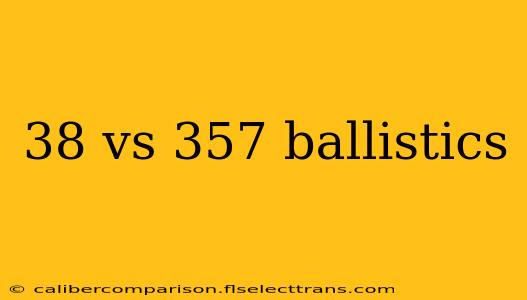Choosing between a .38 Special and a .357 Magnum often comes down to personal preference and intended use. Both cartridges are popular, reliable, and have a long history, but they exhibit significant differences in ballistic performance, recoil, and suitability for various applications. This detailed comparison explores the key ballistic characteristics of each round to help you make an informed decision.
Understanding Ballistics: Key Metrics
Before diving into the specifics, let's establish the key ballistic metrics we'll be comparing:
- Muzzle Velocity: The speed at which the bullet leaves the barrel. Higher velocity generally translates to flatter trajectory and greater range.
- Muzzle Energy: The kinetic energy of the bullet upon exiting the barrel. Higher muzzle energy indicates greater stopping power.
- Recoil: The backward force felt by the shooter after firing. Heavier recoil can impact accuracy and shooter comfort, especially during extended shooting sessions.
- Trajectory: The path the bullet follows in flight. Higher velocity generally leads to a flatter trajectory.
- Accuracy: The precision with which the bullet strikes the target. This is affected by several factors, including ammunition quality and firearm design.
.38 Special Ballistics: A Classic Performer
The .38 Special, introduced in 1898, is a time-tested cartridge known for its reliability and manageable recoil. It's a popular choice for self-defense, target shooting, and concealed carry. While it's less powerful than the .357 Magnum, its lower recoil makes it suitable for smaller-framed shooters or those new to handguns.
Key Ballistic Characteristics (.38 Special, 158-grain lead round nose):
- Muzzle Velocity: Approximately 800-850 feet per second (fps)
- Muzzle Energy: Approximately 200-220 foot-pounds (ft-lbs)
- Recoil: Moderate
.357 Magnum Ballistics: Powerhouse Performance
The .357 Magnum, introduced in 1935, packs significantly more punch than the .38 Special. Its higher velocity and muzzle energy make it suitable for hunting small game, self-defense (where penetration is paramount), and law enforcement applications. However, the increased power comes at the cost of greater recoil.
Key Ballistic Characteristics (.357 Magnum, 158-grain lead round nose):
- Muzzle Velocity: Approximately 1,200-1,400 fps (depending on barrel length and ammunition)
- Muzzle Energy: Approximately 500-600 ft-lbs (depending on barrel length and ammunition)
- Recoil: Substantial
.38 Special vs. .357 Magnum: Side-by-Side Comparison
| Feature | .38 Special | .357 Magnum |
|---|---|---|
| Muzzle Velocity | ~800-850 fps | ~1200-1400 fps |
| Muzzle Energy | ~200-220 ft-lbs | ~500-600 ft-lbs |
| Recoil | Moderate | Substantial |
| Cost | Generally less expensive | Generally more expensive |
| Availability | Widely available | Widely available |
| Intended Use | Target shooting, self-defense, concealed carry | Self-defense, hunting small game, law enforcement |
Which Cartridge is Right for You?
The best cartridge depends entirely on your needs and experience level.
-
Choose the .38 Special if: You prioritize manageable recoil, lower cost, and are new to handguns or have a smaller frame. It's a great option for target practice and self-defense within its limitations.
-
Choose the .357 Magnum if: You need greater stopping power and are comfortable with substantial recoil. It's suitable for hunting small game and self-defense situations requiring greater penetration. Note that .38 Special ammunition can often be fired from a .357 Magnum revolver.
Remember to always practice safe firearm handling and consult with experienced shooters or professionals before making a decision. This information is for educational purposes only and should not be considered professional advice.

